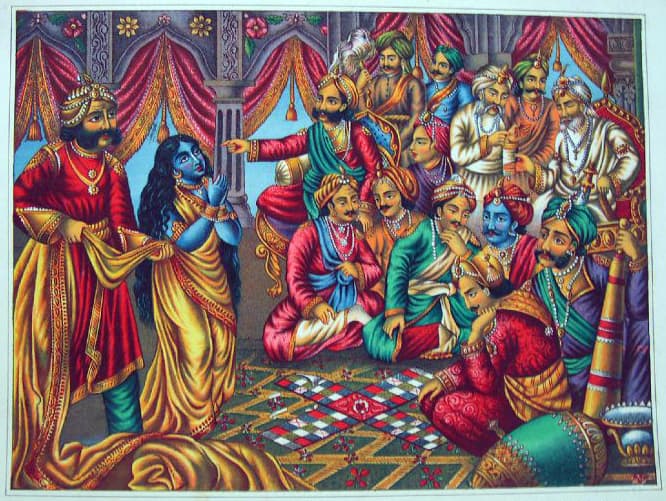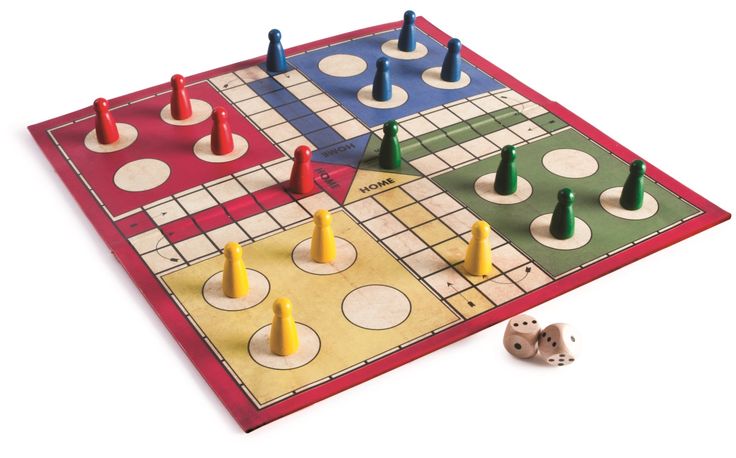Who Invented Ludo?: Ludo, a name evoking nostalgia, gained immense popularity during the pandemic. This legendary game has not only helped us devise a multitude of strategies and tips but also offers valuable real-life lessons. It is revered by both family members and friends alike. Its origin lies in ancient India, with evidence dating back to the Mahabharata and Mughal Empire eras.
Ludo is one of the most popular board games that has been enjoyed by people across generations. It is a game that is loved by people of all ages and is played in almost every corner of the world. It is a board game that has a rich history and has evolved over time into what we know and love today. Here we will explore the history of Ludo, from its ancient origins to its modern-day popularity.
The Birth of Ludo
Ludo, also known as Pachisi, is a board game that has been played for centuries and has a rich history. One of the most interesting aspects of Ludo is its relation to the ancient Indian epic, the Mahabharata.
In the Mahabharata, the Pandavas and Kauravas play a game of dice which eventually leads to the Kurukshetra War. It is believed that this game of dice was the forerunner of the game of Pachisi, which later evolved into Ludo.
Learn more about – Ludo Earning App
According to mythology, the game of Pachisi was invented by Emperor Akbar in the 16th century. He built four courts made of marble for games and used the women of his harem as game pieces. The game was played with a large number of participants, and each player controlled four pieces.

The game of Pachisi was also known as Chaupad, which means “four parts.” The game was played on a cloth or board having a total of 68 squares. The board was divided into four quadrants, each containing 17 squares. Each player had four pieces, which they moved around the board by rolling a puck or dice.
[download]
This game was not only played for entertainment but it was also considered to have religious significance. The game was often played during festivals and celebrations and was believed to bring good luck and prosperity to those who played it.
Over time, twenty-five spread to other parts of the world and went through many variations. In the UK, the game was modified and renamed Ludo, which means “I play” in Latin. The new version of the game became a popular pastime for families and friends and is still enjoyed today.
Learn more about – Incredible Facts About Ludo You Didn’t Know!
History Of Ludo
The history of Ludo dates back to the 6th century CE when it originated in India as a game known as Pachisi. Pachisi resembled the modern-day Ludo but featured four players instead of two. It garnered immense popularity within India and even found mention in the epic poem, the Mahabharata.
In the 1890s, an English man named Alfred Collier Invented a modified version of Pachisi, which he named Ludo. Collier’s Ludo was designed for two players and utilized a cubic die instead of the original four elongated dice. The game swiftly gained traction in England and subsequently spread to various countries worldwide.
During the early 20th century, the Royal Navy embraced Ludo as a source of entertainment during lengthy voyages, introducing slight modifications and renaming it Uckers. To this day, Uckers remains a game played exclusively within the Royal Navy.
Presently, Ludo continues to be a beloved game globally, enjoyed by individuals of all ages. It is available in various formats, including traditional board games, video games, and online versions.
Here are some related articles on the Ludo game:
- Ludo Money Withdrawal Made Easy by Fantasy Khiladi
- Play online Ludo tournaments & win up to ₹10 Lakhs!
- Ludo Android APK Download from Fantasy Khiladi
- Playing Rules of Ludo Game Online at Fantasy Khiladi
- Daily Instant Withdrawal Ludo Earning App
Traditional Ludo Board
Ludo is a board game usually played on a square board divided into four quadrants, with 17 squares in each quadrant. The playing surface of the board is usually painted in bright and vibrant colors, with each quadrant having a different color. The colors used on the board can vary depending on the manufacturer or region of the world, but they are usually red, blue, green, and yellow.
Each quadrant of the board represents a player’s starting and ending areas. The starting area is usually located in the upper left corner of each quadrant and is usually marked with a small circle or square. This is where each player’s pieces are placed at the start of the game.

The finishing area is located in the center of the board and is often marked with a large circle or square. This is where each player’s game piece must reach in order to win the game. The finishing area is usually divided into four smaller sections, one for each player, with each section marked with the player’s respective color.
Also Read: Online Paise Kaise Kamaye Mobile se
The spaces on the board are numbered, with each quadrant having its own number of points. The numbers are usually marked in a clockwise direction, with the starting area number one and the finishing area number 68.
The game is usually played with two to four players, and each player chooses a set of colored game pieces, usually four in number. The game pieces are moved around the board based on the roll of a die or dice. The object of the game is to move all game pieces from the starting area to the finishing area in the center of the board.
Overall, the layout of the Ludo board is simple yet effective, with each player’s area clearly marked and the route to the finishing area well defined. This makes it easy for players to learn the game and understand the rules, while still providing plenty of strategic options and opportunities for competitive gameplay.
Check Out the Four Varients Of Ludo at Fantasy Khiladi
- Ludo Timer – Play Speed Ludo & Win ₹1 Lakh in 6 Min
- Ludo Classic – Play Ludo Battle & Win ₹20 Lakhs Daily
- Ludo Popular – Play Online Ludo Superstar & Win Big Daily
- Ludo Crush – Play Online Ludo Hunt & Win ₹1 Lakh in 6 Min
Ludo Gameplay
Ludo is a classic board game that has been enjoyed by generations of families and friends. It is a game that promotes strategic thinking and friendly competition. The game can be played by 2-4 players, making it a great option for small gatherings or family game nights.
To start the game, each player selects a color and takes four tokens of the same color. These tokens start in the player’s home base, which is located at one corner of the board. The objective of the game is to move all four tokens from the home base to the center of the board, called the “home column.” The first player to move all four tokens to the home column wins the game.
Don’t Miss out – How To Play Ludo Game? Tips and Tricks To Win
To move the tokens, players take turns rolling a dice. The number on the dice determines how many spaces the player can move their tokens. The game can be unpredictable, as players may land on spaces that allow them to move extra spaces or spaces that require them to skip a turn. This element of chance adds to the excitement and fun of the game.
As players progress around the board, they may encounter other players’ tokens. If a player lands on a space occupied by an opponent’s token, the opponent’s token is sent back to their home base. This can be a strategic move to slow down opponents and gain an advantage.
List of international variants
- Uckers, British
- Pachisi, Indian
- Fia, Swedish
- Eile mit Weile (Haste makes Pace), Swiss
- Cờ cá ngựa, Vietnamese
- Parchís, Spanish
- Parqués, Colombian
- Vuelta obligada (mandatory restart)
- Cielo robado (stolen heaven)
- De piedra en piedra (from stone to stone)
- Con Policía (With Policeman)
Ludo Game Rules
The rules of Ludo are simple and easy to understand. Each player takes turns rolling the dice and moving their tokens. The tokens can only move in a clockwise direction around the board. If a player lands on a square occupied by an opponent’s token, the opponent’s token is sent back to the starting point. The first player to move all their tokens to the finish line wins the game. Ludo is a game that is easy to learn and enjoyable to play, making it a great option for families and friends to bond over.
The Popularity of Ludo
Ludo’s popularity soared in the early 21st century when it was introduced to the British Empire. Game two quickly spread throughout the world, and it is now played in countries as diverse as the United States, Brazil, and China. In many countries, Ludo is a staple of family game nights, and it is often played during holidays and special occasions.
One reason for Ludo’s enduring popularity is its simplicity. The rules are easy to learn, and the game can be played by people of all ages. Additionally, Ludo has a competitive aspect that appeals to many players. There is always the chance that one’s opponent will roll the dice just right, leading to a tense and exciting game.
Rise on Mobile platforms
- Fantasy Khiladi Ludo
- Ludo Summer
- MPL Ludo
- Get Rush App Ludo
- Ludo King
- Ludo Club- Fun Dice Game
FAQs
What is the history of Ludo?
Ludo has its origins in ancient India, where it was known as Pachisi. It was played by members of the royalty and was considered a game of strategy and skill.
When was Ludo first introduced to Europe?
Ludo was first introduced to Europe in the late 19th century, where it became popular among the upper classes.
How did Ludo become a popular game worldwide?
Ludo became popular worldwide due to its simple rules and the ability to be played by people of all ages. It also became widely available in the form of board games and electronic games.
What are the rules of Ludo?
Ludo is a game for 2-4 players, each with four game pieces. The objective is to move all the pieces from the starting point to the center of the board, following the numbers on the dice.
What is the significance of the different colored pieces in Ludo?
The different colored pieces in Ludo represent the different players. Each player has their own set of four pieces that are the same color.
Is there a strategy to playing Ludo?
Yes, there are many strategies to playing Ludo, including blocking opponents, moving multiple pieces simultaneously, and using the starting squares to your advantage.
What are some variations of Ludo?
There are many variations of Ludo, including Chinese Checkers, Snakes and Ladders, and Sorry!.
Who are some famous players of Ludo?
There are no specific famous players of Ludo, but it is a popular game among people of all ages and backgrounds.
Is Ludo considered a children’s game?
While Ludo is often played by children, it is a game that can be enjoyed by people of all ages.
What is the modern-day popularity of Ludo?
Ludo is still a popular game worldwide, and has seen a resurgence in popularity in recent years due to the availability of online and mobile versions of the game.
Final Thoughts
The history of Ludo is a fascinating one, full of twists and turns that reflect the game itself. From its origins in India to its rise as a global phenomenon, Ludo has been a source of joy and entertainment for countless people. Its enduring popularity is a testament to its simplicity and competitive spirit, and it shows no signs of slowing down any time soon.







![Top 10 Games in India – Most Popular Games in India [July 2024] top 10 Most Popular Games in India](https://fantasykhiladi.com/blog/wp-content/uploads/2023/06/Most-Popular-Games-in-India-1024x576.jpg)